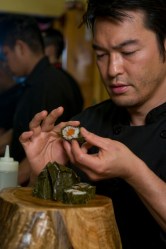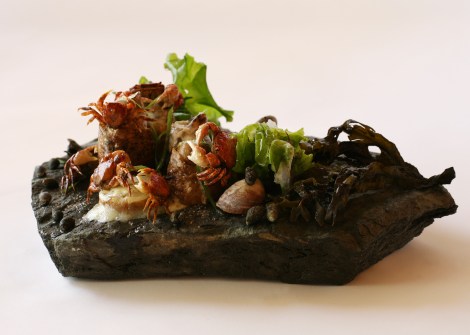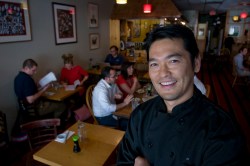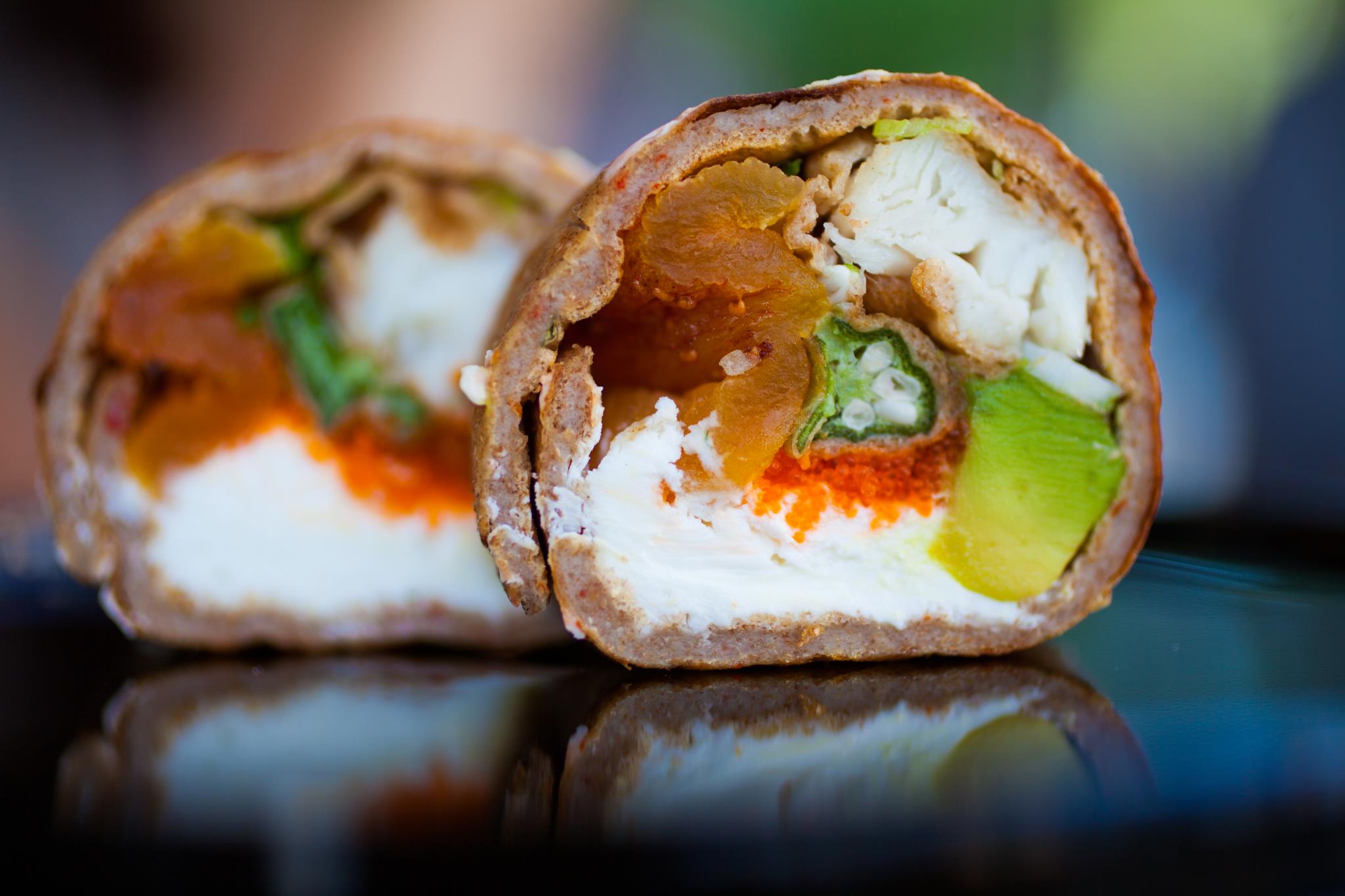
Alan AldoBun Lai making wabisabi.
According to recent reports, bluefin tuna schools are this century’s version of the bison herd: Their luscious red flesh remains extremely popular with sushi diners worldwide — so much so that overfishing has pushed Pacific bluefin stocks to a 96 percent decline since the 1950s. Their extinction as a food source is edging towards reality.
But when the various forms of tuna — toro, otoro, maguro — are so synonymous with Japanese cuisine, is it even possible for sushi to move beyond its cornerstone fish? The science indicates that consuming sushi in a way that’s sustainable has shifted from a nice idea to an absolute necessity in 2013. Bun Lai, chef and owner of Miya’s Sushi restaurant in New Haven, Conn., has carried that ethos from well-meaning notion to practice. He redefines what it means to be a sushi chef by insisting the most popular item should stay off the menu. In tuna’s place, he’s simultaneously turning invasive species into table fare and nudging sushi back to its freshwater origins.
Here, Bun Lai shares his secrets and talks about the cuisine’s future.

Da Ping LuoTyger Tyger, Miya Sushi’s fish-of-the-day roll, often made with tilapia.
Q. How long have you been foraging in Connecticut?
A. I’m by no means an expert, but I’ve been foraging all my life. Both of my parents were nature lovers and we were always outdoors. When my Japanese mother first came to this country from China, she discovered many of the plants she used to collect and eat when she was little also grew in New Haven. I would go out and dig up wild burdock and pick lamb’s quarters. I loved doing it and it sort of grew from there.
Q. How productive is the Long Island Sound as a food source?
A. I’ve been fishing in in the rivers and streams of Connecticut and the Long Island Sound since I was very little. But one of the challenges for the restaurant [is] that we’re looking for fish that are not commercially popular or available. There’s all sorts of sources for local seafood incorporated in the menu like whelks, periwinkles, and tunikit. But what’s really difficult is finding seafood that’s caught in a sustainable or ethical manner.
The irony is there are plenty of bluefish and striped bass swimming around Long Island Sound, but you can’t eat them due to mercury advisories.
Q. So what is the motivation behind culling species introduced to the area?
A. Theoretically, if we were to eat invasive species it would help to restore and regenerate habitats. Today we eat very few species like tuna, in terms of plants and animals. And because of it we’re having a horrifically damaging impact on the living planet.
These days, there are more Asian shore crabs than there are native green crabs in the area, far and away. When I was growing up all you would see would be green crabs. In April we go out for Japanese knotweed. Around the world it does billions and billions of dollars in damage. So for about a month and a half we use the knotweed in recipes, pickling and blanching them. The common denominator for invasive species is their resilience. I grew up eating periwinkles; the common periwinkle is another invasive species in the Long Island Sound.
Q. Are some of these ingredients not seen on menus more often because they’re hard to obtain or difficult to process?
A. It’s easy to get, because it’s a matter of just going out and collecting them. [But] a lot of stuff is not the kind of food people are used to eating. You really have to open their minds to eating it. One of the most sensual dishes that we have on our menu and [was] mentioned in Saveur magazine and [on] the Food Network is kanibaba, our invasive shore crab dish. We know that it’s delicious and that people like it. When you look at it in that light it’s really no big deal at all. It’s really a matter of putting it front of people.

Bun LaiThe kanibaba, Miya Sushi’s invasive-crab answer to the California roll.
Q. Do you get much pushback from customers when they realize there no sushi mainstays on the menu?
A. Most of the people walking into Miya’s know what to expect; we have a lot of return customers. Once in a while we get customers that pop in expecting a traditional sushi restaurant based on a Google search without having read the reviews. And they ask for mainstays of sushi like California roll, which is our kanibaba. Or a tuna roll, but instead of tuna we have a lionfish dish.
We don’t win everyone over. We still have people walking out on us. But we have simple and earnest answers to explain why we do what we do. Six out of eight of the most popular tuna are threatened species. And the ones that aren’t threatened are caught in a manner that’s destructive to the ecosystem, with extraordinary bycatch.
Q. Does idealism get in the way of running the restaurant?
A. I think the most important thing in the creation of my cuisine is to understand that you can’t make can’t make everybody happy. Not everybody is going to appreciate it, or like [it], and some will think it’s complete trash. People have to realize they have a far-reaching impact in their choices.
The challenge has been to stop serving the bedrock ingredient of modern sushi. When I thought about doing it a couple years ago and discussed it with my top staff, people were hyperventilating. But for me, if I know that I’m doing the right thing [but] it’s scary at the same time, then I know I should do it.
Q. Has it helped you develop as a chef?

Alan AldoBun Lai in his restaurant.
A. Cooking is my bushido. The first thing I am is an artist; my food speaks for itself. People come to me because they can’t get the kind of food we create anywhere else in the world. The most important thing for me in the creation of my cuisine and my business is that they’re completely intertwined. And I’m always checking myself to make wise choices.
My mother opened Miya’s in 1982. [It was] the first sushi bar in Connecticut. She wanted to create a traditional Japanese food that was healthy. Today my mom loves the food as it’s evolved.
Our techniques are very different in every in possible way from most contemporary sushi chefs — starting with the rice we use, a whole-grain medley, [and] our soy sauce is citrus-based. We use local maple syrup. None of this stuff is a secret. We gave our recipes to Eating Well magazine in an eight-page article on eating sustainable sushi.
Q. Now that you’ve taken tuna and shrimp off the menu at Miya’s, how do you reconcile that with running a sushi restaurant?
A. People have to understand that food as culture is constantly evolving. American cuisine is not the same as it was in 1950, for better and for worse. And to understand where food is going, it’s good to know its past. If you’re talking about sushi, the cuisine developed over thousands of years with rice along the Mekong Delta. It’s a river cuisine. In the beginning there was no tuna sushi. It was all freshwater fish packed and fermented with rice. The people were eating catfish, carp, and freshwater bass. Today all over Asia there are really ancient ways in which fish is fermented in rice. In rural Japan there’s narezushi, a carp-based sushi. It smells like the stinkiest cheese imaginable.
Original sushi wasn’t like anything it is today today. In a lot of ways we’re tipping our hats to the genesis of sushi by not using ingredients considered to be the bedrock of sushi.
Q. Can you give credence to the rumor that jellyfish is the next tofu?
A. The Koreans, Chinese, and Japanese eat them. Will it be the next tofu? I doubt it [laughs]. We use jellyfish at Miya’s in a dish called Peanut Butter and Jelly with wild hunted hare or animal welfare-approved rabbit. When jellyfish is dried and rehydrated again the texture changes completely. People like it for the texture, not the flavor. If you were to dehydrate tofu, which people actually do, it’s similar to jellyfish.
We named it after a conventional American staple. We’re trying to have people rethink what is traditional and classic food. Our work is about changing people’s perspectives, and [we hope] to move and inspire them in many different ways.



